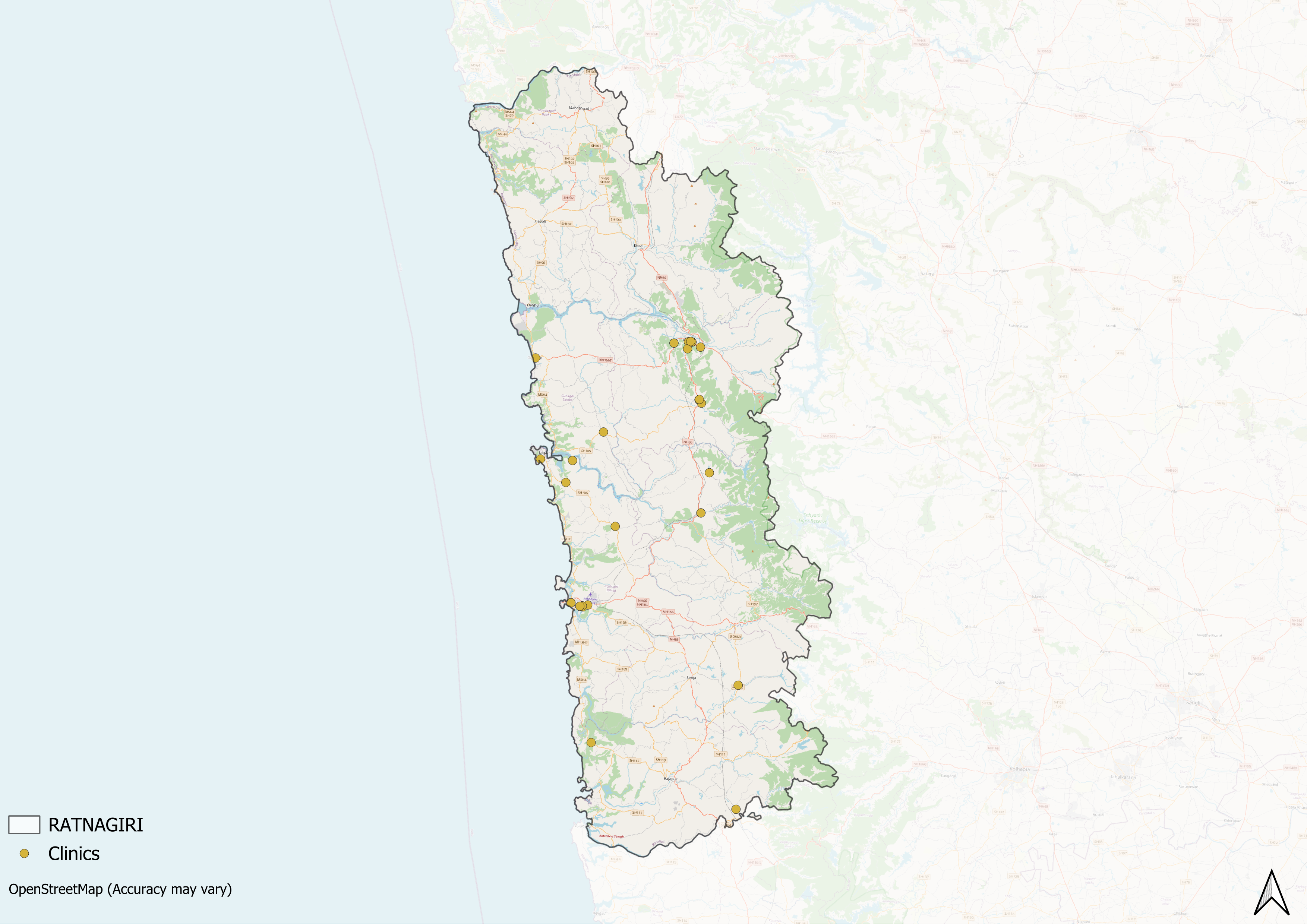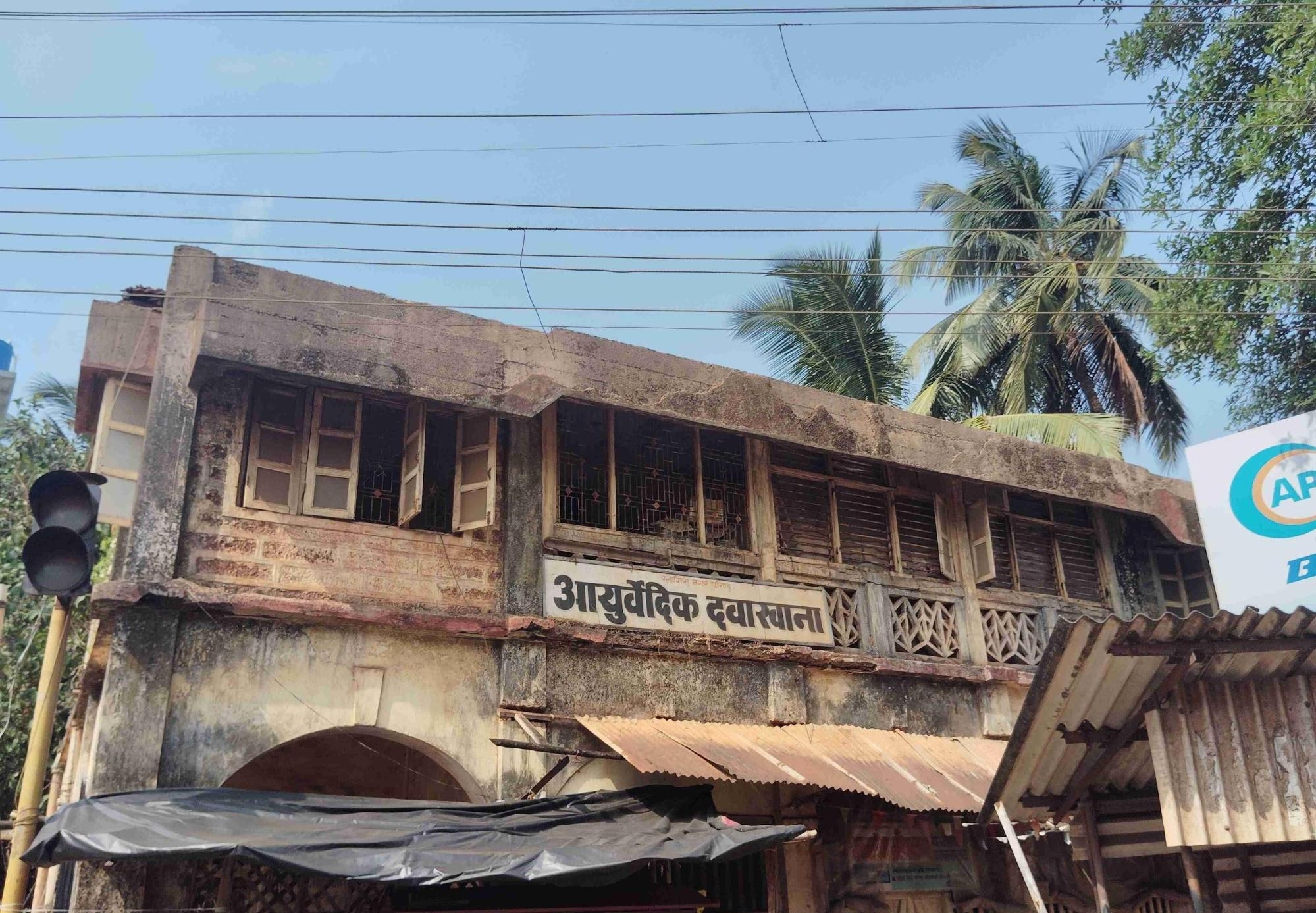Contents
- Healthcare Infrastructure
- Age-Old Practices & Remedies
- NGOs & Initiatives
- The Walawalkar Hospital
- Graphs
- Healthcare Facilities and Services
- A. Public and Govt-Aided Medical Facilities
- B. Private Healthcare Facilities
- C. Approved vs Working Anganwadi
- D. Anganwadi Building Types
- E. Anganwadi Workers
- F. Patients in In-Patients Department
- G. Patients in Outpatients Department
- H. Outpatient-to-Inpatient Ratio
- I. Patients Treated in Public Facilities
- J. Operations Conducted
- K. Hysterectomies Performed
- L. Share of Households with Access to Health Amenities
- Morbidity and Mortality
- A. Reported Deaths
- B. Cause of Death
- C. Reported Child and Infant Deaths
- D. Reported Infant Deaths
- E. Select Causes of Infant Death
- F. Number of Children Diseased
- G. Population with High Blood Sugar
- H. Population with Very High Blood Sugar
- I. Population with Mildly Elevated Blood Pressure
- J. Population with Moderately or Severely High Hypertension
- K. Women Examined for Cancer
- L. Alcohol and Tobacco Consumption
- Maternal and Newborn Health
- A. Reported Deliveries
- B. Institutional Births: Public vs Private
- C. Home Births: Skilled vs Non-Skilled Attendants
- D. Live Birth Rate
- E. Still Birth Rate
- F. Maternal Deaths
- G. Registered Births
- H. C-section Deliveries: Public vs Private
- I. Institutional Deliveries through C-Section
- J. Deliveries through C-Section: Public vs Private Facilities
- K. Reported Abortions
- L. Medical Terminations of Pregnancy: Public vs Private
- M. MTPs in Public Institutions before and after 12 Weeks
- N. Average Out of Pocket Expenditure per Delivery in Public Health Facilities
- O. Registrations for Antenatal Care
- P. Antenatal Care Registrations Done in First Trimester
- Q. Iron Folic Acid Consumption Among Pregnant Women
- R. Access to Postnatal Care from Health Personnel Within 2 Days of Delivery
- S. Children Breastfed within One Hour of Birth
- T. Children (6-23 months) Receiving an Adequate Diet
- U. Sex Ratio at Birth
- V. Births Registered with Civil Authority
- W. Institutional Deliveries through C-section
- X. C-section Deliveries: Public vs Private
- Family Planning
- A. Population Using Family Planning Methods
- B. Usage Rate of Select Family Planning Methods
- C. Sterilizations Conducted (Public vs Private Facilities)
- D. Vasectomies
- E. Tubectomies
- F. Contraceptives Distributed
- G. IUD Insertions: Public vs Private
- H. Female Sterilization Rate
- I. Women’s Unmet Need for Family Planning
- J. Fertile Couples in Family Welfare Programs
- K. Family Welfare Centers
- L. Progress of Family Welfare Programs
- Immunization
- A. Vaccinations under the Maternal and Childcare Program
- B. Infants Given the Oral Polio Vaccine
- C. Infants Given the Bacillus Calmette Guerin (BCG) Vaccine
- D. Infants Given Hepatitis Vaccine (Birth Dose)
- E. Infants Given the Pentavalent Vaccines
- F. Infants Given the Measles or Measles Rubella Vaccines
- G. Infants Given the Rotavirus Vaccines
- H. Fully Immunized Children
- I. Adverse Effects of Immunization
- J. Percentage of Children Fully Immunized
- K. Vaccination Rate (Children Aged 12 to 23 months)
- L. Children Primarily Vaccinated in (Public vs Private Health Facilities)
- Nutrition
- A. Children with Nutritional Deficits or Excess
- B. Population Overweight or Obese
- C. Population with Low BMI
- D. Prevalence of Anaemia
- E. Moderately Anaemic Women
- F. Women with Severe Anaemia being Treated at an Institution
- G. Malnourishment Among Infants in Anganwadis
- Sources
RATNAGIRI
Health
Last updated on 9 July 2025. Help us improve the information on this page by clicking on suggest edits or writing to us.
Ratnagiri’s healthcare landscape, like many other regions across India, is shaped by a mix of indigenous and Western medical practices. For centuries, communities in the district depended on local healers such as hakims and vaidyas, who treated illnesses using plants, herbs, and other resources found in the surrounding forests and fields. This use of local knowledge and natural remedies formed the base of early healthcare in Satara before formal hospitals were established. Over time, these practices continued alongside the introduction and expansion of more specialised medical services.
Healthcare Infrastructure
Similar to other regions in India, Ratnagiri’s healthcare infrastructure follows a multi-tiered system that involves both public and private sectors. The public healthcare system is structured into primary, secondary, and tertiary levels. Primary care is provided through Sub Centres and Primary Health Centres (PHCs), secondary care is managed by Community Health Centres (CHCs) and Sub-District hospitals, while tertiary care, the highest level, is delivered through Medical Colleges and District Hospitals.


Supporting this structure is a network of Accredited Social Health Activists (ASHAs) who, as described by the National Health Mission, serve as “an interface between the community and the public health system.” Over time, this multi-layered healthcare model has been continuously shaped and refined by national healthcare policies and reforms to improve universal health coverage across regions.
Ratnagiri’s formal healthcare system, like much of India’s, has its roots in the 19th century during British rule. According to the colonial District Gazetteer (1880), by 1878, the district had three key civil hospitals, including facilities in Ratnagiri, Dapoli, and Sawantwadi. Some of these hospitals were originally built as British civil or military bases before being repurposed for public health use.
Among these, the Ratnagiri Civil Hospital has a unique history. Established in 1878, the building was first constructed as a criminal jail on the outskirts of town before it was converted into a hospital. In its early years, the facility included a large ward for men, as well as smaller wards for women and individuals with mental health conditions.
![District Hospital, Ratnagiri[1]](/media/statistic/images/maharashtra/ratnagiri/health/district-hospital-ratnagiri1-337d0846.png)
The Dapoli Civil Hospital, founded in 1860, had initially served as an arms and ammunition storage facility for the Veteran Battalion before becoming a public hospital.
In 1875, the Ratnagiri Leper Hospital was founded with significant support from Parsi philanthropist Dinsha Manikji Petit. Dedicated to leprosy treatment, it became known locally as the “Leprosy Hospital” for its focused care. The district Gazetteer (1880) noted that leprosy was especially prevalent in the inland parts of Ratnagiri, with many patients coming from Hindu Maratha and Kunbi agricultural communities.
Another early facility was the Ratnagiri Mental Hospital, now known as the Regional Mental Hospital, which was established in 1886 as one of the first mental health institutions built under the colonial government. For many years, it remained one of only four public mental health facilities serving the wider State.
Over time, however, the public health network expanded beyond these early institutions, and by the 20th and 21st centuries, private hospitals and charitable trusts also began setting up new facilities, often driven by local organisations, community initiatives, and NGOs.
Age-Old Practices & Remedies
Historically, before the advent of Western health care systems or the three-tiered healthcare infrastructure that exists today, people in the district relied on and made use of indigenous knowledge and medicine for their well-being. When it comes to healthcare in India, it has long been characterized by a pluralistic health tradition. Among the many medicine systems that have a long history in India and in Ratnagiri, as locals say, are Ayurveda and Unani.
Historically, Vaidyas in Ratnagiri have been highly regarded for their diagnostic and therapeutic expertise. Even today, Ayurvedic treatments remain prevalent in the district, with traditional dawakhanas (clinics) still visible throughout the region.

NGOs & Initiatives
The determinants of health and health outcomes, as the World Health Organization (WHO) elaborates, are not solely shaped by more than just medical factors and healthcare services. The organization uses the term “social determinants of health (SDH)” to refer to the “non-medical factors that influence health outcomes.” These non-medical factors can be sanitation, nutrition, community well-being, or, as the WHO outlines, “income and social protection,” “food security,” access to quality healthcare, and more.
While there have been ongoing efforts to strengthen Ratnagiri district’s healthcare infrastructure, certain areas still face challenges, particularly in addressing these broader health determinants. In response, non-governmental organizations have emerged as vital partners, working alongside public health systems to develop innovative, grassroots-level approaches that bridge these gaps.
The Walawalkar Hospital
One such effort is the work of Kaka Maharaj and Kamlakarpant Walawalkar, whose vision led to the founding of Walawalkar Hospital. In 1995, a healthcare facility was set up in Dervan village, an area then considered underdeveloped, through the combined efforts of two private trusts. The hospital was established to provide general healthcare services and address local needs where public facilities were limited.
![Walawalkar Hospital, Devran, Ratnagiri district[2]](/media/statistic/images/maharashtra/ratnagiri/health/walawalkar-hospital-devran-ratnagiri-distr_eKScOWx.png)
Since it began operating, the hospital has run regular medical camps for women over 40 years of age, offering medical tests, basic treatment, and transport free of cost. These camps aim to reach women who may otherwise have limited access to healthcare due to economic or social constraints.
In 2000, the hospital also started the Walawalkar Ladoo Yojana to address local nutritional gaps. As part of this effort, ladoos made from groundnuts, cereals, jaggery, and herbs are distributed to children, pregnant women, and adolescent girls. The aim is to provide iron, calcium, and protein affordably in areas where undernutrition remains a concern.
![Distribution under the Walawalkar Ladoo Yojana in Ratnagiri district.[3]](/media/statistic/images/maharashtra/ratnagiri/health/distribution-under-the-walawalkar-ladoo-yo_pxZdOL5.png)
Graphs
Healthcare Facilities and Services
Morbidity and Mortality
Maternal and Newborn Health
Family Planning
Immunization
Nutrition
Sources
Gaikwad, J. D., & Jadhav, P. V. 2020. "An Ethnobotanical Analysis on Flora-Medicine Continuum Among the Tribal Inhabitants of Ratnagiri and Palghar District, Maharashtra, India." ResearchGate. www.researchgate.net/publication/346017660_An_ethnobotanical_analysis_on_flora-medicine_continuum_among_the_tribal_inhabitants_of_Ratnagiri_and_Palghar_district_Maharashtra_Indiahttps://www.researchgate.net/publication/346…
J.M. Campbell. 1880. Gazetteer of the Bombay Presidency: Ratnagiri and Savantvadi, Vol. X. The Government Central Press.https://archive.org/details/dli.ministry.084…
Kapoor, Srishti. 2014. "Keeping Ratnagiri Healthy and Happy." Srishti Kapoor Blog. srishtikapoor4.wordpress.com/2014/02/08/keeping-ratnagiri-healthy-and-happy/https://srishtikapoor4.wordpress.com/2014/02…
M Choksi, B. Patil et al. 2016. Health systems in India. Vol 36 (Suppl 3). Journal of Perinatology. pmc.ncbi.nlm.nih.gov/articles/PMC5144115/https://pmc.ncbi.nlm.nih.gov/articles/PMC514…
National Health Mission (NHM). "About Accredited Social Health Activist (ASHA)." National Health Mission, India. nhm.gov.in/index1.php?lang=1&level=1&sublinkid=150&lid=226#:~:text=One%20of%20the%20key%20components,performing%20her%20spelled%20out%20roles.https://nhm.gov.in/index1.php?lang=1&level=1…
Social determinants of health. WHO. www.who.int/health-topics/social-determinants-of-health#tab=tab_1https://www.who.int/health-topics/social-det…
Somasundaram, O., & Ganesan, S. 2021. "Mental Hospitals and Historical Trauma: Stop Repeating Past Mistakes." Vol. 37, no. 4. Indian Journal of Social Psychiatry. journals.lww.com/ijsp/fulltext/2021/37040/mental_hospitals_and_historical_trauma__stop.11.aspxhttps://journals.lww.com/ijsp/fulltext/2021/…
Walawalkar Hospital. "About Us." Walawalkar Hospital. walawalkarhospital.com/about-us/https://walawalkarhospital.com/about-us/
Walawalkar Hospital. "Walawalkar Laddoo Gopal Yojana." Walawalkar Hospital. walawalkarhospital.com/community-service/walawalkar-laddoo-gopal-yojana/https://walawalkarhospital.com/community-ser…
Last updated on 9 July 2025. Help us improve the information on this page by clicking on suggest edits or writing to us.